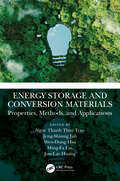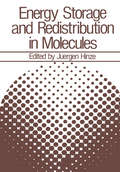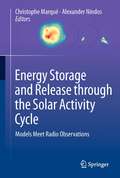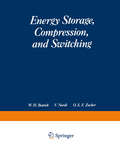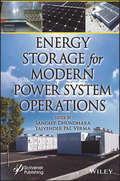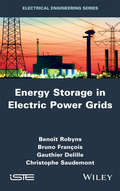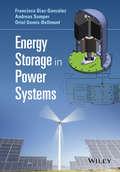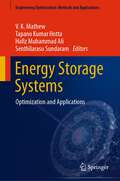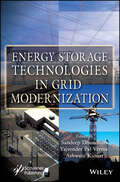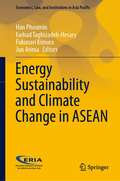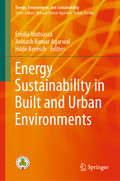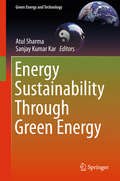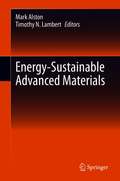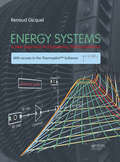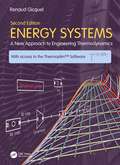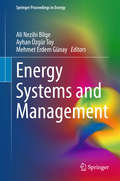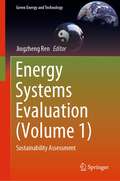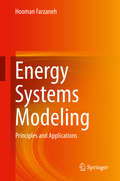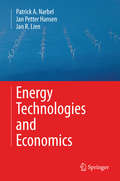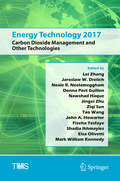- Table View
- List View
Energy Storage and Conversion Materials: Properties, Methods, and Applications
This book explores the fundamental properties of a wide range of energy storage and conversion materials, covering mainstream theoretical and experimental studies and their applications in green energy. It presents a thorough investigation of diverse physical, chemical, and material properties of rechargeable batteries, supercapacitors, solar cells, and fuel cells, covering the development of theoretical simulations, machine learning, high-resolution experimental measurements, and excellent device performance. Covers potential energy storage (rechargeable batteries and supercapacitors) and energy conversion (solar cells and fuel cells) materials Develops theoretical predictions and experimental observations under a unified quasi-particle framework Illustrates up-to-date calculation results and experimental measurements Describes successful synthesis, fabrication, and measurements, as well as potential applications and near-future challenges Promoting a deep understanding of basic science, application engineering, and commercial products, this work is appropriate for senior graduate students and researchers in materials, chemical, and energy engineering and related disciplines.
Energy Storage and Redistribution in Molecules
by Jürgen HinzeWe characterize an isolated molecule by its compos~t~on, i.e. the number and types of atoms forming the molecule, its structure, i.e. the geometrical arrangement of the composite atoms with respect to each other, and its possible, i.e. quantum mechanically allowed, stationary energy states. Conceptually we separate the latter, being aware that this is an approximation, into electronic, vibrational and rotational states, including fine and hyperfine structure splittings. To be sure, there is an intimate relation between molecular structure and molecular energy states, in fact it is this relation we use, when we obtain structural information through spectroscopy, where we determine transitions between various stationary states of the molecule. The concepts above have proven extremely useful in chemistry and spectroscopy, however, the awareness of the limitations of these concepts has grown in recent years with the increasing recognition of (i) fluctional molecules, (ii) multiphoton absorption processes and (iii) influences due to the surroundings on "isolated" molecules.
Energy Storage and Release through the Solar Activity Cycle: Models Meet Radio Observations
by Alexander Nindos Christophe MarqueFor nearly sixty years, radio observations have provided a unique insight into the physics of the active and quiescent solar atmosphere. Thanks to the variety of emission mechanisms and to the large altitude range available to observations, fundamental plasma parameters have been measured from the low chromosphere to the upper corona and interplanetary medium. This book presents current research in solar radio astronomy and shows how well it fits in the exceptional scientific context brought by the current space solar observatories. It essentially contains contributed research and review papers presented during the 2010 Community of European Solar Radio Astronomers (CESRA) meeting, which took place in Belgium in June 2010. This book is aimed at graduate students and researchers working in solar physics and space science. Previously published in Solar Physics journal, Vol. 273/2, 2011.
Energy Storage, Compression, and Switching
by W. BostickThis international conference was organized by the sponsoring agencies with the following objectives in mind: to bring together active researchers involved in energy compression, switching, and storage who have a major interest in plasma physics, electron beams, electric and magnetic energy storage systems, and high voltage and high current switches. Areas of interest include: Slow systems: 50-60 Hz machinery, transformers, flywheel-homopolar generators, slow capacitors, inductors, and solid state switches. Inter mediate systems: fast capacitor banks, superconducting storage and switch ing, gas, vacuum, and dielectric switching, nonlinear (magnetic) switching, 5 6 fast (10 - 10 Hz) capacitors and fuses. Fast systems: Marx, Blumlein, oil, water, and pressurized water dielectrics, switches, magnetic insula tion, electron beams, and plasmas. The Editors extend thanks to all the authors, and attendees (and their supporting institutions, and companies), everyone of whom in his own measure helped to make the conference a success. The Editors further wish to thank the members of the Scientific Committee for the help they have given in organizing the conference and in editing, especially J. C. Martin and H. L. Laquer. Special recognition is due the Lawrence Livermore Laboratory whose Electrical Engineering Department provided the Secretary of the Scientific Committee and one of the Editors, and the yeowoman services of Sharon Dodson and Cheri Johnson in all the mailings, correspondence, and receiving and organizing of the manuscripts. The LLL Technical Information Department provided the design and printing of the conference announcements and the instructional formats for the authors' manuscripts.
Energy Storage for Modern Power System Operations
by Sandeep Dhundhara Yajvender Pal VermaENERGY STORAGE for MODERN POWER SYSTEM OPERATIONS Written and edited by a team of well-known and respected experts in the field, this new volume on energy storage presents the state-of-the-art developments and challenges for modern power systems for engineers, researchers, academicians, industry professionals, consultants, and designers. Energy storage systems have been recognized as the key elements in modern power systems, where they are able to provide primary and secondary frequency controls, voltage regulation, power quality improvement, stability enhancement, reserve service, peak shaving, and so on. Particularly, deployment of energy storage systems in a distributed manner will contribute greatly in the development of smart grids and providing promising solutions for the above issues. The main challenges will be the adoption of new techniques and strategies for the optimal planning, control, monitoring and management of modern power systems with the wide installation of distributed energy storage systems. Thus, the aim of this book is to illustrate the potential of energy storage systems in different applications of modern power systems, with a view toward illuminating recent advances and research trends in storage technologies. This exciting new volume covers the recent advancements and applications of different energy storage technologies that are useful to engineers, scientists, and students in the discipline of electrical engineering. Suitable for the engineers at power companies and energy storage consultants working in the energy storage field, this book offers a cross-disciplinary look across electrical, mechanical, chemical and renewable engineering aspects of energy storage. Whether for the veteran engineer or the student, this is a must-have for any library. AUDIENCE Electrical engineers and other designers, engineers, and scientists working in energy storage
Energy Storage for Modern Power System Operations
by Sandeep Dhundhara Yajvender Pal VermaENERGY STORAGE for MODERN POWER SYSTEM OPERATIONS Written and edited by a team of well-known and respected experts in the field, this new volume on energy storage presents the state-of-the-art developments and challenges for modern power systems for engineers, researchers, academicians, industry professionals, consultants, and designers. Energy storage systems have been recognized as the key elements in modern power systems, where they are able to provide primary and secondary frequency controls, voltage regulation, power quality improvement, stability enhancement, reserve service, peak shaving, and so on. Particularly, deployment of energy storage systems in a distributed manner will contribute greatly in the development of smart grids and providing promising solutions for the above issues. The main challenges will be the adoption of new techniques and strategies for the optimal planning, control, monitoring and management of modern power systems with the wide installation of distributed energy storage systems. Thus, the aim of this book is to illustrate the potential of energy storage systems in different applications of modern power systems, with a view toward illuminating recent advances and research trends in storage technologies. This exciting new volume covers the recent advancements and applications of different energy storage technologies that are useful to engineers, scientists, and students in the discipline of electrical engineering. Suitable for the engineers at power companies and energy storage consultants working in the energy storage field, this book offers a cross-disciplinary look across electrical, mechanical, chemical and renewable engineering aspects of energy storage. Whether for the veteran engineer or the student, this is a must-have for any library. AUDIENCE Electrical engineers and other designers, engineers, and scientists working in energy storage
Energy Storage in Electric Power Grids
by Benoît Robyns Bruno François Gauthier Delille Christophe SaudemontThis book deals with the management and valuation of energy storage in electric power grids, highlighting the interest of storage systems in grid applications and developing management methodologies based on artificial intelligence tools. The authors highlight the importance of storing electrical energy, in the context of sustainable development, in "smart grids", and discuss multiple services that storing electrical energy can bring. Methodological tools are provided to build an energy management system storage following a generic approach. These tools are based on causal formalisms, artificial intelligence and explicit optimization techniques and are presented throughout the book in connection with concrete case studies.
Energy Storage in Electric Power Grids
by Benoît Robyns Bruno François Gauthier Delille Christophe SaudemontThis book deals with the management and valuation of energy storage in electric power grids, highlighting the interest of storage systems in grid applications and developing management methodologies based on artificial intelligence tools. The authors highlight the importance of storing electrical energy, in the context of sustainable development, in "smart grids", and discuss multiple services that storing electrical energy can bring. Methodological tools are provided to build an energy management system storage following a generic approach. These tools are based on causal formalisms, artificial intelligence and explicit optimization techniques and are presented throughout the book in connection with concrete case studies.
Energy Storage in Power Systems
by Francisco Díaz-González Andreas Sumper Oriol Gomis-BellmuntOver the last century, energy storage systems (ESSs) have continued to evolve and adapt to changing energy requirements and technological advances. Energy Storage in Power Systems describes the essential principles needed to understand the role of ESSs in modern electrical power systems, highlighting their application for the grid integration of renewable-based generation. Key features: Defines the basis of electrical power systems, characterized by a high and increasing penetration of renewable-based generation. Describes the fundamentals, main characteristics and components of energy storage technologies, with an emphasis on electrical energy storage types. Contains real examples depicting the application of energy storage systems in the power system. Features case studies with and without solutions on modelling, simulation and optimization techniques. Although primarily targeted at researchers and senior graduate students, Energy Storage in Power Systems is also highly useful to scientists and engineers wanting to gain an introduction to the field of energy storage and more specifically its application to modern power systems.
Energy Storage in Power Systems
by Francisco Díaz-González Andreas Sumper Oriol Gomis-BellmuntOver the last century, energy storage systems (ESSs) have continued to evolve and adapt to changing energy requirements and technological advances. Energy Storage in Power Systems describes the essential principles needed to understand the role of ESSs in modern electrical power systems, highlighting their application for the grid integration of renewable-based generation. Key features: Defines the basis of electrical power systems, characterized by a high and increasing penetration of renewable-based generation. Describes the fundamentals, main characteristics and components of energy storage technologies, with an emphasis on electrical energy storage types. Contains real examples depicting the application of energy storage systems in the power system. Features case studies with and without solutions on modelling, simulation and optimization techniques. Although primarily targeted at researchers and senior graduate students, Energy Storage in Power Systems is also highly useful to scientists and engineers wanting to gain an introduction to the field of energy storage and more specifically its application to modern power systems.
Energy Storage Systems: Optimization and Applications (Engineering Optimization: Methods and Applications)
by Hafiz Muhammad Ali Tapano Kumar Hotta V. K. Mathew Senthilarasu SundaramThis book discusses generalized applications of energy storage systems using experimental, numerical, analytical, and optimization approaches. The book includes novel and hybrid optimization techniques developed for energy storage systems. It provides a range of applications of energy storage systems on a single platform. The book broadly covers—thermal management of electronic components in portable electronic devices; modeling and optimization aspects of energy storage systems; management of power generation systems involving renewable energy; testing, evaluation, and life cycle assessment of energy storage systems, etc. This book will serve as a reference resource for researchers and practitioners in academia and industry.
Energy Storage Technologies in Grid Modernization
by Sandeep Dhundhara Yajvender Pal Verma Ashwani KumarENERGY STORAGE TECHNOLOGIES IN GRID MODERNIZATION Written and edited by a team of experts, this exciting new volume discusses the various types of energy storage technologies, the applications of energy storage systems, their role in the real-time operation of power markets, and the operational issues of modern power systems, including renewable-based generating sources. The worldwide energy sector, specifically power generation, has undergone a huge transformation in recent years, and the focus is to make it sustainable, environmentally friendly, reliable, and highly efficient. As a result, a significant share of highly intermittent but clean renewable sources is being integrated into the power system using advanced technological components. The higher penetration level of renewable energy sources (RESs) has increased the active power generation share in the grid but reduced the total rotating system inertia. This high reduction in inertia brings new challenges and technical issues to the operators of modern power systems and impacts the stability and security of the grid. The stochasticity of these renewable sources also poses a big challenge to the efficient operation of the power system. Electrical energy storage systems help to manage such issues and challenges that occur due to the intermittent nature of RES and can play a big role in the smooth and reliable operation of the power system. The applications and opportunities to use storage on the grid are growing due to the improvements in energy storage technologies, and flexible regulatory frameworks. Technological developments have made it possible to use batteries and other Energy Storage Systems (ESSs) for managing the operation of the power system. This book aims to illustrate the potential of energy storage systems in different applications of the modern power system considering recent advances and research trends in storage technologies. These areas are going to play a very significant role in future smart grid operations. This book discusses the various types of energy storage technologies and promotes the applications of ESSs in the performance improvement of modern power systems. Whether for the veteran engineer, new hire, or student, it is a must-have for any library.
Energy Storage Technologies in Grid Modernization
by Sandeep Dhundhara Yajvender Pal Verma Ashwani KumarENERGY STORAGE TECHNOLOGIES IN GRID MODERNIZATION Written and edited by a team of experts, this exciting new volume discusses the various types of energy storage technologies, the applications of energy storage systems, their role in the real-time operation of power markets, and the operational issues of modern power systems, including renewable-based generating sources. The worldwide energy sector, specifically power generation, has undergone a huge transformation in recent years, and the focus is to make it sustainable, environmentally friendly, reliable, and highly efficient. As a result, a significant share of highly intermittent but clean renewable sources is being integrated into the power system using advanced technological components. The higher penetration level of renewable energy sources (RESs) has increased the active power generation share in the grid but reduced the total rotating system inertia. This high reduction in inertia brings new challenges and technical issues to the operators of modern power systems and impacts the stability and security of the grid. The stochasticity of these renewable sources also poses a big challenge to the efficient operation of the power system. Electrical energy storage systems help to manage such issues and challenges that occur due to the intermittent nature of RES and can play a big role in the smooth and reliable operation of the power system. The applications and opportunities to use storage on the grid are growing due to the improvements in energy storage technologies, and flexible regulatory frameworks. Technological developments have made it possible to use batteries and other Energy Storage Systems (ESSs) for managing the operation of the power system. This book aims to illustrate the potential of energy storage systems in different applications of the modern power system considering recent advances and research trends in storage technologies. These areas are going to play a very significant role in future smart grid operations. This book discusses the various types of energy storage technologies and promotes the applications of ESSs in the performance improvement of modern power systems. Whether for the veteran engineer, new hire, or student, it is a must-have for any library.
Energy Sustainability and Climate Change in ASEAN (Economics, Law, and Institutions in Asia Pacific)
by Han Phoumin Farhad Taghizadeh-Hesary Fukunari Kimura Jun ArimaThis book provides several up-to-date empirical policy-oriented studies on assessing the impacts of climate change on various economic sectors and the role of renewable energy resources in mitigating pollution and climate change. It suggests various policy recommendations on how to increase the share of renewable energy resources in the energy baskets of the members of the Association of Southeast Asian Nations (ASEAN) and the rest of the world to ensure energy sustainability. As of 2020, most of the world’s energy investment still went to carbon-emitting sources, namely, fossil fuels. On the other hand, the Covid-19 pandemic and the economic Project Overview 20 March 2021 08:39 Page 6 of 9 downturns shrank the global energy demand, including fossil fuels, resulting in a sharp drop in their prices. Low fossil fuel prices are harmful to developing renewable energy projects, making solar, wind, and other renewable energy resources less competitive as sources of electricity. This is endangering the Paris agreement and the “Climate Action” goal of the United Nations. Given the high share of fossil fuels in the energy mix of the members of ASEAN, tremendous challenges must be faced for their energy transition in the post-Covid-19 world. The authors call for sound policy and applicable technologies to ensure sustainable energy availability, accessibility, and affordability to reach emission reduction targets.
Energy Sustainability in Built and Urban Environments (Energy, Environment, and Sustainability)
by Avinash Kumar Agarwal Emilia Motoasca Hilde BreeschThis book covers different aspects of energy sustainability in residential buildings and neighborhoods, starting from the construction and design aspects, and moving on to HVAC systems and lighting, and the applications, harvesting, use and storage of renewable energy. The volume focuses on smart and sustainable use of energy, discussing both the technological advancements and the economic, social and environmental impacts. Novel approaches to recycling of waste and materials in the context of residential buildings are also presented. This volume will be of interest to researchers and policy makers working in the fields of renewable energy, sustainable design and city planning.
Energy Sustainability Through Green Energy (Green Energy and Technology)
by Atul Sharma Sanjay Kumar KarThis book shares the latest developments and advances in materials and processes involved in the energy generation, transmission, distribution and storage. Chapters are written by researchers in the energy and materials field.Topics include, but are not limited to, energy from biomass, bio-gas and bio-fuels; solar, wind, geothermal, hydro power, wave energy; energy-transmission, distribution and storage; energy-efficient lighting buildings; energy sustainability; hydrogen and fuel cells; energy policy for new and renewable energy technologies and education for sustainable energy development.
Energy-Sustainable Advanced Materials
by Mark Alston Timothy N. LambertThis book highlights progress towards the capture, storage, and utilization of energy through the development of advanced materials and systems based on abundant elements, materials, and commodities. Energy is critical to human sustainability and a global-scale deployment of renewable energy systems will be required. Hence, the chapters integrate the fundamental aspects that enable the technical advancements in detail, along with an emphasis on the need for highly sustainable materials to enable real impact for humankind: To determine innovation of energy capture and storage through characterizations of materials in areas of electrical generation and electrical storage systems; To demonstrate better performance, economic and environmental advantages than the current state of the art; To define new chemistries and materials for innovations in energy density design through lower operational temperatures, improve safety, expanding operational voltage, battery durability lifetimes, and reduce system costs. Advances critical technical and commercial objectives for novel high energy density materials;Evaluates operational material models for optimizing energy capture that are integrated by configurations as a system; Illustrates utilization of material life cycle assessment for high energy outputs generators for sustainable materials.
Energy Systems: A New Approach to Engineering Thermodynamics
by Renaud GicquelConsidered as particularly difficult by generations of students and engineers, thermodynamics applied to energy systems can now be taught with an original instruction method. Energy Systems applies a completely different approach to the calculation, application and theory of multiple energy conversion technologies. It aims to create the reader's fo
Energy Systems: A New Approach to Engineering Thermodynamics
by Renaud GicquelConsidered as particularly difficult by generations of students and engineers, thermodynamics applied to energy systems can now be taught with an original instruction method. Energy Systems applies a completely different approach to the calculation, application and theory of multiple energy conversion technologies. It aims to create the reader’s foundation for understanding and applying the design principles to all kinds of energy cycles, including renewable energy. Proven to be simpler and more reflective than existing methods, it deals with energy system modeling, instead of the thermodynamic foundations, as the primary objective. Although its style is drastically different from other textbooks, no concession is made to coverage: with encouraging pace, the complete range from basic thermodynamics to the most advanced energy systems is addressed. The accompanying Thermoptim™ portal (http://thermoptim.org) presents the software and manuals (in English and French) to solve over 200 examples, and programming and design tools for exercises of all levels of complexity. The portal explains to the user how to build appropriate models to bridge the technological reality with the theoretical basis of energy engineering. Offering quick overviews through e-learning modules moreover, the portal is user-friendly and enables users to quickly improve their proficiency. Students can freely download the Thermoptim modeling software demo version (available in seven languages), and extended options are available to lecturers. A professional edition is also available and has been adopted by many companies and research institutes worldwide (www.s4e2.com). This volume is intended as a textbook for courses in applied thermodynamics, energy systems, energy conversion and thermal engineering taken by senior undergraduate and graduate-level students in mechanical, energy, chemical and petroleum engineering. Students should already have taken a first-year course in thermodynamics. The refreshing approach and exceptionally rich coverage make it a great reference tool for researchers and professionals as well.
Energy Systems: A New Approach to Engineering Thermodynamics
by Renaud GicquelConsidered as particularly difficult by generations of students and engineers, thermodynamics applied to energy systems can now be taught with an original instruction method. Energy Systems applies a completely different approach to the calculation, application and theory of multiple energy conversion technologies. It aims to create the reader’s foundation for understanding and applying the design principles to all kinds of energy cycles, including renewable energy. Proven to be simpler and more reflective than existing methods, it deals with energy system modeling, instead of the thermodynamic foundations, as the primary objective. Although its style is drastically different from other textbooks, no concession is made to coverage: with encouraging pace, the complete range from basic thermodynamics to the most advanced energy systems is addressed. The accompanying Thermoptim™ portal (http://thermoptim.org) presents the software and manuals (in English and French) to solve over 200 examples, and programming and design tools for exercises of all levels of complexity. The portal explains to the user how to build appropriate models to bridge the technological reality with the theoretical basis of energy engineering. Offering quick overviews through e-learning modules moreover, the portal is user-friendly and enables users to quickly improve their proficiency. Students can freely download the Thermoptim modeling software demo version (available in seven languages), and extended options are available to lecturers. A professional edition is also available and has been adopted by many companies and research institutes worldwide (www.s4e2.com). This volume is intended as a textbook for courses in applied thermodynamics, energy systems, energy conversion and thermal engineering taken by senior undergraduate and graduate-level students in mechanical, energy, chemical and petroleum engineering. Students should already have taken a first-year course in thermodynamics. The refreshing approach and exceptionally rich coverage make it a great reference tool for researchers and professionals as well.
Energy Systems and Management (Springer Proceedings in Energy)
by Ali Nezihi Bilge Ayhan Özgür Toy Mehmet Erdem GünayReaders of this work will find examinations of the current status and future status for energy sources and technologies, their environmental interactions and the relevant global energy policies. The work begins with an overview of Energy Technologies for a Sustainable Future, which examines the correlation between population, economy and energy consumption in the past, and reviews the conventional and renewable energy sources as well as the management of them to sustain the ever-growing energy demand in the future. The rest of the chapters are divided into 3 parts; the first part of the book, “Energy Sources, Technologies and Environment”, consists of 12 chapters, which include research on new energy technologies and evaluation of their environmental effects. The second part “Advanced Energy Materials” includes 7 chapters devoted to research on material science for new energy technologies. The final section titled “Energy Management, Economics and Policy” is comprised of 10 chapters about planning, controlling and monitoring energy related processes together with the policies to satisfy the needs of increasing population and growing economy. The chapters are selected works from the International Conference on Energy and Management, which was organized by Istanbul Bilgi University Department of Energy Systems Engineering and PALMET Energy to share the knowledge on the recent trends, scientific developments, innovations and management methods in energy, and held on 5–7th June 2014 at Istanbul Bilgi University.
Energy Systems Evaluation: Sustainability Assessment (Green Energy and Technology)
by Jingzheng RenThis book presents various methods for sustainability assessment of energy systems, under various different conditions and scenarios. It answers the questions of how to measure the sustainability of energy systems by adopting appropriate metrics and methods. This book provides readers with a comprehensive view of the frontiers of sustainability assessment methods for energy system analysis. It presents various methodologies, allowing readers to understand: the complete metrics for sustainability assessment; life cycle thinking for sustainability assessment of energy systems; and the advanced sustainability assessment methods for energy systems. This book is of interest to researchers, engineers, decision makers, and postgraduate students within the field of energy systems, sustainability, and decision analysis.
Energy Systems Modeling: Principles and Applications
by Hooman FarzanehThis book serves as an introductory reference guide for those studying the application of models in energy systems. The book opens with a taxonomy of energy models and treatment of descriptive and analytical models, providing the reader with a foundation of the basic principles underlying the energy models and positioning these principles in the context of energy system studies. In turn, the book provides valuable insights into the varied applications of different energy models to answer complex questions, including those concerning specific aspects of energy policy measures dealing with issues of supply and demand. Case studies are provided in all of the chapters, offering real-world examples of how existing models fit the classification methods outlined here. The book’s remaining chapters address a broad range of principles and applications, taking the reader from the basic principles involved, to state-of-the-art energy production and consumption processes, using modeling and validation/illustration in case studies to do so. With its in-depth mathematical foundation, this book serves as a comprehensive collection of work on modeling energy systems and processes, taking inexperienced graduate students from the basics through to a high-level understanding of the modeling processes in question, while also providing professionals and academic researchers in the field of energy planning with an up-to-date reference guide covering the latest works.
Energy Technologies and Economics
by Patrick A. Narbel Jan Petter Hansen Jan R. LienThis is an easy-to-read textbook providing the reader with the basis to comprehend the major energy technologies from a physical and economical perspective.The journey through the book begins with some background theory on the physics and economics of energy. Major energy technologies (fossil, nuclear and renewable) are explored in-depth, explaining how they work and the costs involved. Finally, the journey ends by exploring the technical and economic feasibility of supplying the world by 2050 with sustainable energy only.Numerous examples are provided to allow the reader to relate important concepts to real-life. The reader’s understanding of the material can then be tested using the exercises at the end of each chapter.This textbook is the first to thoroughly present the physics and the economics of energy. It is intended for graduate students and practitioners interested in the field of energy. It also enables the general reader to distinguish between political statement and fact.
Energy Technology 2017: Carbon Dioxide Management and Other Technologies (The Minerals, Metals & Materials Series)
by Lei Zhang Jaroslaw W. Drelich Neale R. Neelameggham Donna Post Guillen Nawshad Haque Jingxi Zhu Ziqi Sun Tao Wang John A Howarter Fiseha Tesfaye Shadia Ikhmayies Elsa Olivetti Mark William KennedyThis collection focuses on energy efficient technologies including innovative ore beneficiation, smelting technologies, recycling and waste heat recovery. The volume also covers various technological aspects of sustainable energy ecosystems, processes that improve energy efficiency, reduce thermal emissions, and reduce carbon dioxide and other greenhouse emissions. Papers addressing renewable energy resources for metals and materials production, waste heat recovery and other industrial energy efficient technologies, new concepts or devices for energy generation and conversion, energy efficiency improvement in process engineering, sustainability and life cycle assessment of energy systems, as well as the thermodynamics and modeling for sustainable metallurgical processes are included. This volume also offers topics on CO2 sequestration and reduction in greenhouse gas emissions from process engineering, sustainable technologies in extractive metallurgy, as well as the materials processing and manufacturing industries with reduced energy consumption and CO2 emission. Contributions from all areas of non-nuclear and non-traditional energy sources, such as solar, wind, and biomass are also included in this volume.Papers from the following symposia are presented in the book:Energy TechnologiesAdvances in Environmental Technologies: Recycling and Sustainability Joint SessionDeriving Value from Challenging Waste Materials: Recycling and Sustainability Joint SessionSolar Cell Silicon
